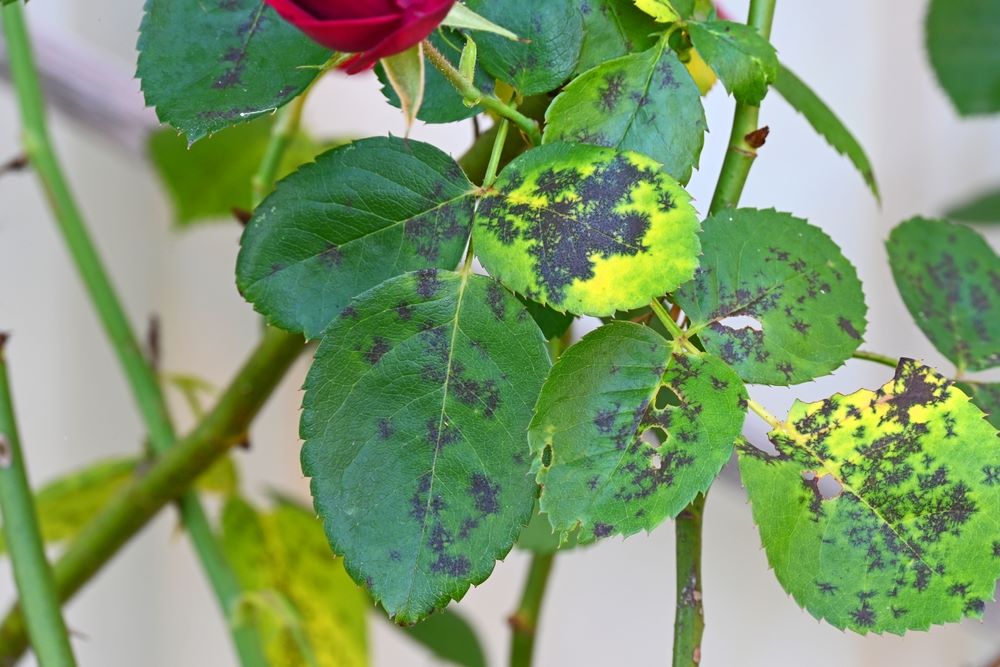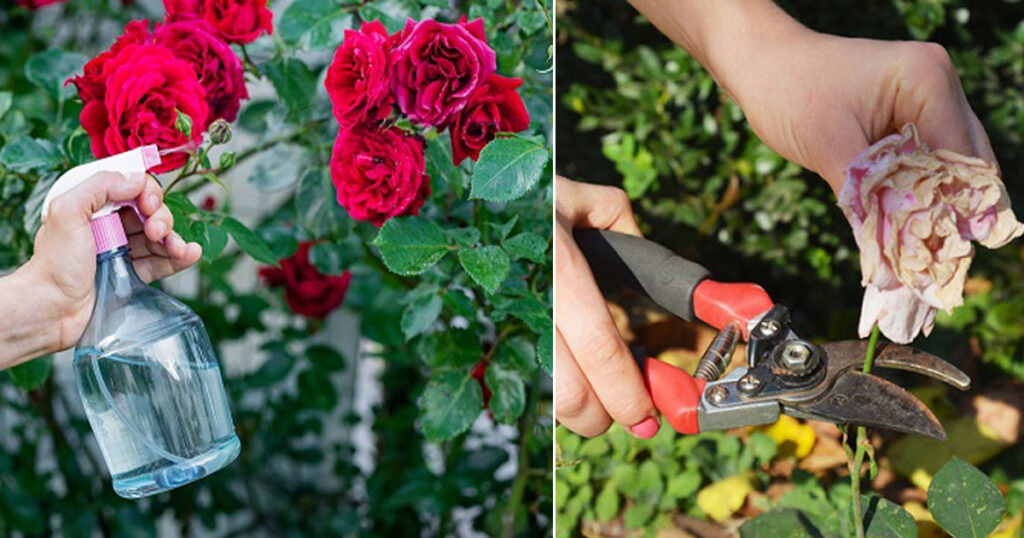I’ve developed a comprehensive approach to treating and preventing these common ailments. In this guide, I’ll share my hard-won knowledge to help you keep your rose garden thriving.
Understanding Rose Plant Diseases
Rose plants are susceptible to various diseases that can hinder their growth and beauty. Identifying these diseases early is crucial for effective treatment. Here are some of the most common rose plant diseases I’ve encountered:
Black Spot
Black spot is a fungal disease that causes dark, circular spots on rose leaves. I’ve found it to be particularly prevalent in humid climates.

Powdery Mildew
This fungal infection appears as a white, powdery coating on leaves and stems. It thrives in warm, dry conditions with high humidity.
Rust
Rust manifests as orange or reddish-brown pustules on the undersides of leaves. It can quickly spread and weaken the plant if left untreated.
Botrytis Blight
Also known as gray mold, this fungal disease affects flowers, leaves, and stems, causing them to rot and turn brown.
Rose Mosaic Virus
This viral infection causes yellow patterns on leaves and can stunt plant growth. Unfortunately, there’s no cure, but proper management can help.

Treatment Methods
I’ve developed a multi-faceted approach to treating rose plant diseases. Here are some effective methods I’ve used:
Cultural Controls
- Proper Pruning: Regularly remove diseased or dead plant material to improve air circulation and reduce disease spread.
- Watering Techniques: Water at the base of the plant in the morning to allow foliage to dry quickly, reducing fungal growth.
- Soil Management: Maintain well-draining soil and avoid overwatering to prevent root diseases.
Organic Treatments
- Neem Oil: This natural fungicide and insecticide has been a game-changer in my garden. It’s effective against various fungal diseases and pests.
- Baking Soda Solution: A mixture of baking soda, water, and a drop of dish soap can help control fungal diseases like powdery mildew.
- Milk Spray: A diluted milk solution can be surprisingly effective against powdery mildew.

Chemical Controls
While I prefer organic methods, sometimes chemical treatments are necessary for severe infections:
- Fungicides: Systemic fungicides can be effective against persistent fungal diseases.
- Insecticides: For pest-related issues that lead to disease, targeted insecticides may be necessary.
Prevention: The Key to Healthy Roses
In my experience, prevention is far more effective than treatment. Here are some strategies I use to keep my roses healthy:
- Choose Resistant Varieties: Select rose varieties that are naturally resistant to common diseases in your area.
- Proper Spacing: Plant roses with adequate space between them to promote air circulation.
- Regular Inspections: Check your plants frequently for signs of disease or pest infestation.
- Balanced Nutrition: Provide your roses with appropriate fertilization to boost their natural defenses.
- Clean Tools: Sanitize your gardening tools between uses to prevent disease spread.

Exciting Developments in Rose Disease Treatment
The world of rose cultivation is constantly evolving, with new research and technologies emerging to help gardeners combat diseases more effectively. Here are some exciting developments I’m keeping an eye on:
- Biocontrol Agents: Scientists are exploring the use of beneficial microorganisms to suppress plant pathogens naturally.
- Genetic Engineering: Researchers are working on developing roses with enhanced disease resistance through genetic modification.
- Smart Sensors: New technologies are emerging that can detect plant diseases before visible symptoms appear, allowing for earlier intervention.
- Nanotechnology: Nanoparticles are being studied for their potential to deliver disease-fighting compounds more effectively to plants.

Conclusion:
Dealing with rose plant diseases can be challenging, but it’s also an opportunity to deepen your connection with your garden. Each challenge you overcome makes you a more skilled and knowledgeable gardener.
Remember, a healthy rose garden is a testament to your dedication and care. By implementing the strategies outlined in this guide, you’ll be well on your way to cultivating a vibrant, disease-resistant rose garden that brings joy and beauty to your life.
As you continue your rose gardening journey, stay curious, be patient, and don’t be afraid to experiment. With time and experience, you’ll develop your own unique approach to rose care that works best for your garden and climate.
People also ask:
Q: How often should I treat my roses for disease prevention?
A: I recommend a preventive treatment every 7-14 days during the growing season, depending on your local climate and disease pressure.
Q: Can I use homemade remedies to treat rose diseases?
A: Yes, many homemade solutions like neem oil and baking soda sprays can be effective. However, for severe infections, you may need to use commercial products.
Q: Are some rose varieties more disease-resistant than others?
A: Absolutely! Many modern rose cultivars have been bred for disease resistance. Look for varieties labeled as “disease-resistant” or consult with local rose societies for recommendations.
Q: How can I tell if my rose has a disease or a pest problem?
A: Careful observation is key. Diseases typically cause discoloration, spotting, or abnormal growth on leaves and stems. Pest damage often appears as holes in leaves or distorted growth. When in doubt, consult a local extension office or experienced gardener.
Q: Can rose diseases spread to other plants in my garden?
A: Some rose diseases can affect other plants, particularly those in the same family. It’s best to isolate infected plants and treat them promptly to prevent spread.
Read also: https://plantgrowup.com/how-to-grow-grape-plants-at-home/